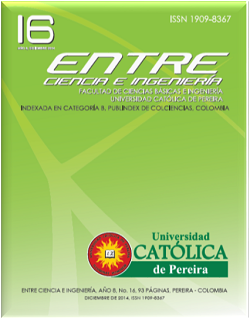LMI sliding mode control approach for electromechanical systems
DOI:
https://doi.org/10.31908/19098367.593Keywords:
linear matrix inequalities, sliding modes, robot manipulators, sensor faultAbstract
This paper presents a control approach that is based on the combination of Linear Matrix Inequalities and Sliding mode control. This approach is appropriate
to electromechanical systems like robotic manipulators, helicopter models, inverted pendulum systems and so. The proposed control law is has two parts: a linear component and a nonlinear component. The linear component is designed with the objective to track an appropriate reference model given. The nonlinear control component provides robustness in face nonlinearities, disturbances, parametric uncertainties and sensor faults. The performance of proposed controller is tested in two examples: the PR and ELBOW robot models, which are simulated in Simulink of MATLAB®.
Downloads
References
J. Craig, Robótica. Pearson Education, 2006, pp. 173–188.
O. I. Higuera-Martínez and J. M. Salamanca, “Diseño de un controlador LMI+I basado en optimizaron para un helicóptero de dos grados de libertad,” Ing. Investig. y Desarro., vol. 5, pp. 22–28, 2007.
J. M. Salamanca, E. J. Avella-Rodríguez, and R. A. Plazas-Rosas, “Control por LMI-Modos deslizantes aplicado a una clase de sistemas no lineales.,” in VII Congreso Internacional sobre Innovación y Desarrollo Tecnológico. CIINDET 2010, 2010, pp. 1–8.
S. Zein-Sabatto, J. Sztipanovitis, and G. E. Cook, “A multiplecontrol strategy for robot manipulators,” in IEEE Proceedings of the SOUTHEASTCON ’91, pp. 309–313.
I. Bonilla, E. J. González-Galván, C. Chávez-Olivares, M. Mendoza, A. Loredo-Flores, and F. Reyes, “A vision-based, impedance control strategy for industrial robot manipulators,” in 2010 IEEE International Conference on Automation Science and Engineering, 2010.
S. P. Chan and W.-B. Gao, “Variable structure model-reaching control strategy for robot manipulators,” in Proceedings, 1989 International Conference on Robotics and Automation, pp. 1504–1508.
S. Islam and X. P. Liu, “Robust Sliding Mode Control for Robot Manipulators,” IEEE Trans. Ind. Electron., vol. 58, no. 6, pp. 2444– 2453, Jun. 2011.
A. H. Al-Bayati, “A robust new nonlinear fault tolerant control for robot via an observer,” in 2011 9th World Congress on Intelligent Control and Automation, 2011, pp. 529–534.
B. K. Post and W. J. Book, “A robust nonlinear observation strategy for the control of flexible manipulators,” in 2011 IEEE International Conference on Robotics and Automation, 2011, pp. 2166–2171.
J. M. Salamanca and E. E. Rosero Garcia, “Sliding mode control with linear matrix inequalities using only output information,” in 2005 International Conference on Industrial Electronics and Control Applications, pp. 1–6.
S. B. and L. E. G. and F. and V. B. E., Linear Matrix Inequalities in System and Control Theory. Philadelphia, PA: SIAM, 1994.
O. Pérez and W. Colmenares, “Desigualdades lineales matriciales en el diseño integrado de procesos,” Jornadas de Automática, pp. 1–7, 2002.
J. M. Salamanca and J. M. Ramirez Scarpetta, “Diseño de PSS Utilizando Desigualdades Matriciales Lineales,” in Memorias del Simposio Internacional sobre la Calidad de la Energía Eléctrica - SICEL, 2005.
S. Almeida and R. E. Araujo, “Fault-tolerant control using sliding mode techniques applied to multi-motor electric vehicle,” in IECON 2013 - 39th Annual Conference of the IEEE Industrial Electronics Society, 2013, pp. 3530–3535.
E. J. Avella and R. A. Plazas, “Design of a Gain Scheduling Control Based on Linear Matrix Inequalities for a Dynamic System,” IEEE Latin America Transactions, vol. 10, no. 2. pp. 1459–1465, 2012.
K. J. Aström and B. Wittenmark, Computer-Controlled Systems: Theory and Design, 3rd ed. Upper Saddle River, NJ: Prentice Hall, 1997, pp. 1–557.
K. H. Khalil, Nonlinear Systems, 3rd ed. Upper Saddle River: Prentice Hall, 1996, pp. 3–6.
J. M. Salamanca and R.-D. OO, “Análisis y diseño de sistemas de control de nivel para dos tanques interconectados aplicando desigualdades matriciales lineales (LMI’s),” Ing. Investig. y Desarro., vol. 3, pp. 61–65, 2006.
L. Vandenberghe and V. Balakrishnan, “Algorithms and software for LMI problems in control,” IEEE Control Syst. Mag., vol. 17, no. 5, pp. 89–95, 1997.
J.-J. E. Slotine and W. LI, Applied Nonlinear Control. Prentice Hall, 1991.
E. J. Avella-Rodríguez and R. A. Plazas-Rosas, “Laboratorio Virtual para simular un robot de dos articulaciones ELBOW,” Universidad Pedagógica y Tecnológica de Colombia, 2010.






 Revista Entre Ciencia e Ingeniería
Revista Entre Ciencia e Ingeniería .png) entrecei@ucp.edu.co
entrecei@ucp.edu.co.png) ISSN (Impreso) 1909-8367 - ISSN (En Línea) 2539-4169
ISSN (Impreso) 1909-8367 - ISSN (En Línea) 2539-4169 Attribution-NonCommercial 4.0 International (CC By-NC 4.0)
Attribution-NonCommercial 4.0 International (CC By-NC 4.0)
.png) Carrera 21 No. 49-95 Av. de las Américas, Pereira, Risaralda, Colombia
Carrera 21 No. 49-95 Av. de las Américas, Pereira, Risaralda, Colombia